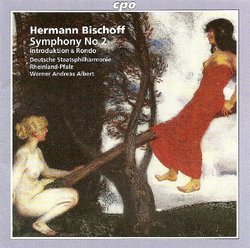| All Artists: Hermann Bischoff, Werner Andreas Albert, Rheinland-Pfalz Staatsphilharmonie Title: Herman Bischoff: Symphony No. 2 Members Wishing: 0 Total Copies: 0 Label: Cpo Records Original Release Date: 1/1/2008 Re-Release Date: 10/28/2008 Genre: Classical Styles: Historical Periods, Modern, 20th, & 21st Century, Symphonies Number of Discs: 1 SwapaCD Credits: 1 UPC: 761203720620 |
Search - Hermann Bischoff, Werner Andreas Albert, Rheinland-Pfalz Staatsphilharmonie :: Herman Bischoff: Symphony No. 2
 | Hermann Bischoff, Werner Andreas Albert, Rheinland-Pfalz Staatsphilharmonie Herman Bischoff: Symphony No. 2 Genre: Classical |
Larger Image |
CD Details |
CD ReviewsObscure gold Sheldon Rosner | Calabasas, CA | 01/14/2009 (5 out of 5 stars) "Once in a while, an unknown composer's works are recorded and you wonder why they had languished in obscurity. Such is the case with this one. He's in the Mahler-Richard Strauss vein but maintains his own sound. If you are a late romantic adventurer, then explore this guy. There are only the first two symphonies available but it's a start." Bischoff's Second and Last Symphony, Plus a Late Masterpiece J Scott Morrison | Middlebury VT, USA | 12/30/2008 (4 out of 5 stars) "I was eager to hear more of the music of Hermann Bischoff (1868-1936) after getting to know his First Symphony (1906) released by cpo a couple of years ago. Performed by the same forces as on the earlier CD -- the Staatsphilharmonie Rheinland-Pfalz (Ludwigshafen) under Werner Andreas Albert -- Bischoff's Second Symphony (1911) represents an advance over the First in that the composer frees himself to some degree from the Straussian mold he had earlier followed. He had been a pupil of Richard Strauss, although only four years younger, and his friend (and fellow skat player) for the rest of his life. He was the son of a rich man -- a Duisberg steel manufacturer -- who didn't have to work for a living. Perhaps this is why he didn't write much music. Indeed, after the premiere of this symphony he lived another twenty-five years and wrote very little more music but what he wrote does, though, include the other work on this disc, the Introduction and Rondo (1925).
The Symphony is in the usual four movements and it lasts about forty-three minutes. The first movement, Allegro non troppo, is a somewhat disjointed twelve-minute sonata allegro that has some noble themes and a harmonic language that sounds less like Strauss and more like, say, Dvorák admixed with some of the brass chorale and fanfare gestures of Bruckner. This is not great music but it is nonetheless satisfying in a general way. The second and third movements, however, are really memorable. The second, a scherzo (called 'Intermezzo. Vivace.'), is an almost Mendelssohnian jeu d'esprit but with late nineteenth-century orchestration and form (one could almost imagine it as a teutonic sibling of Dukas' 'Sorceror's Apprentice' or of one of Tchaikovsky's ballet scherzos). It whirls by in about five minutes. The third movement, Adagio, was surprisingly called the weakest of the four movements in the 'Die Musik' review of the symphony's première. But this fifteen-minute pool of repose is, for me, the emotional and musical center of the work. It is characterized by its utter serenity, memorable themes and gorgeous orchestration that is primarily string-based. The ten-minute finale, Allegro molto, galumphs in almost Brucknerian fashion and in spite of its brilliant orchestration is less striking than the preceding slow movement. All in all, though, this symphony represents an advance in both form and content for Bischoff. One only wishes he had, in the remaining years of his life, returned to the form. The final work presented is the Introduction and Rondo. It is not clear if it was originally conceived to be part of a larger work. The two sections -- the three-minute Introduction and thirteen-minute Rondo -- are played without pause. The Introduction is a wistfully tentative piece laced with agitated but ephemeral muted fanfares and islands of repose; the thrust of the piece is to lead us to ... something. And that something is the gloriously inventive and satisfying Rondo, marked Allegro grazioso. Its primary theme is a tender and melancholy strain whose initial appearance does not suggest it could bear the weight expected of a recurring rondo, but by means of variation and imaginative orchestration it fulfills that function heroically. There is a prominent secondary theme that is more robust but also less recurrent; it offers a balance for the more reticent main theme. Orchestrational variety glides past in stately garb, sometimes demanding of attention, other times almost hiding in the background. This is a subtly thought out example of sophisticated compositional inspiration and skill and it makes us all the more wishful that Bischoff had not stopped composing in his latter years. As with the earlier recording, Albert and the Palatinate orchestra do themselves proud. It is of note that the antecedent of this orchestra presented the première of the Second Symphony and although it probably has not played it again until the recent past, they do so now with obviously proud ownership. Recommended for those who love relatively non-neurotic late Romantic orchestral music. Scott Morrison " |
